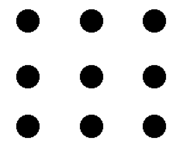Thinking outside the box
From Wikipedia, the free encyclopedia
Thinking outside the box is to think differently, unconventionally or from a new perspective. This phrase often refers to novel, creative and smart thinking.
This is sometimes called a process of lateral thought. The catchphrase, or cliché, has become widely used in business environments, especially by management consultants and executive coaches, and has spawned a number of advertising slogans.
[edit] Origin
The origin of the phrase is somewhat obscure. John Adair claims to have introduced the problem in 1969[1]. Management consultant Mike Vance has claimed that the use of the nine-dot puzzle in consultancy circles stems from the corporate culture of the Walt Disney Company, where the puzzle was used in-house.[2] Both Martin Kihn of Fast Company[3] and the Random House Word Mavens[4] agree that the phrase relates to a traditional topographical puzzle called the nine dots puzzle.
According to Kihn, consultants of the 1970s and 1980s tried to make their prospective clients feel inferior by presenting them with the puzzle. The challenge is to connect the dots by drawing four straight, continuous lines, and never lifting the pencil from the paper. The puzzle is easily solved, but only if you draw the lines outside of the confines of the square area defined by the nine dots themselves. Thus, the phrase "thinking outside the box" was born. The Word Mavens refer to Prof. Daniel Kies of the College of DuPage, who observes that the puzzle only seems difficult because "we imagine a boundary around the edge of the dot array."

The nine dots puzzle is much older than the slogan. It appears in Sam Loyd's 1914 Cyclopedia of Puzzles.[5] In the 1951 compilation The Puzzle-Mine: Puzzles Collected from the Works of the Late Henry Ernest Dudeney, the puzzle is attributed to Dudeney himself.[6]
Sam Loyd's original formulation of the puzzle[7] called it "Christopher Columbus's egg puzzle." Envisioning the target dots of the puzzle as eggs makes it clear that they have area and are not infinitesimally small points, or that the strokes that connect them have width. Either of these features allows a three-line solution (near-parallel lines that meet far away from the nine points) or even a one-line solution (using a line wide enough to touch all nine points).
[edit] See also
- Seven Bridges of Königsberg
- Conceptual framework
- Paradigm
- Egg of Columbus
- No-win situation
- Kobayashi Maru
- Gordian Knot
- Endless knot
[edit] References
- ^ The Art of Creative Thinking: How to Be Innovative and Develop Great Ideas
- ^ Biography of Mike Vance at Creative Thinking Association of America.
- ^ "Outside the Box": The Inside Story, retr/ Aug. 2, 2006.
- ^ The Mavens' Word of the Day, "Outside the Box Thinking", retr. Aug. 2, 2006.
- ^ Sam Loyd, Cyclopedia of Puzzles. (The Lamb Publishing Company, 1914)
- ^ J. Travers, The Puzzle-Mine: Puzzles Collected from the Works of the Late Henry Ernest Dudeney. (Thos. Nelson, 1951)
- ^ Facsimile from Cyclopedia of Puzzles - Columbus's Egg Puzzle is on right-hand page



